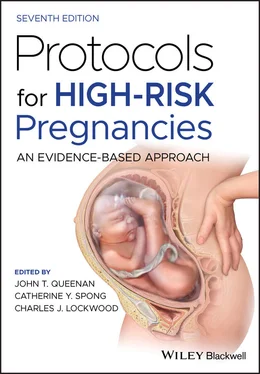The risk period for an episode of MDE coincides with the period of women’s fertility. While some women benefit from psychotherapy and can avoid pharmacotherapy in pregnancy, this is not always the case. Women who have underlying bipolar disorder and those with severe recurrent major depressive disorder will likely require medication management. Antipsychotic agents have a lower risk profile than anticonvulsant mood stabilizers, which should be avoided early in pregnancy. Antidepressants are not major teratogens but clinicians need to apprise patients of potential risks and benefits of treatment, including perinatal complications such as preterm birth or transient neonatal distress.
1 American Psychiatric Association. Diagnostic and Statistical Manual of Mental Disorders, 5th edn. Washington, DC: American Psychiatric Association, 2013.
2 Chambers C, Hernandez‐Diaz H, Marter LV, et al. Selective serotonin‐reuptake inhibitors and risk of persisitent pulmonary hypertension of the newborn. N Engl J Med 2006; 354:579–87.
3 Hermann A, Gorun A, Benudis A. Lithium use and non‐use for pregnant and postpartum women with bipolar disorder. Curr Psychiatry Rep 2019; 21(11):114.
4 Kallen B, Reis M. Neonatal complications after maternal concomitant use of SSRI and other central nervous system active drugs during the second or third trimester of pregnancy. J Clin Psychopharmacol 2012; 32(5):608–14.
5 McKenna K, Koren G, Tetelbaum M, et al. Pregnancy outcome of women using atypical antipsychotic drugs: a prospective comparative study. J Clin Psychiatry 2005; 66(4):444–9; quiz 546.
6 Ross LE, Grigoriadis S, Mamisashvili L, et al. Selected pregnancy and delivery outcomes after exposure to antidepressant medication: a systematic review and meta‐analysis. JAMA Psychiatry 2013; 70(4):436–43.
7 Yonkers K, Blackwell K, Glover J, Forray A. Antidepressant use in pregnant and postpartum women. Annu Rev Clin Psychol 2014; 10:369–92.
8 Yonkers KA, Norwitz ER, Smith MV, et al. Depression and serotonin reuptake inhibitor treatment as risk factors for preterm birth. Epidemiology 2012; 23(5):677–85.
PART 2 Antenatal Testing
PROTOCOL 5 Prenatal Testing for Chromosomal Abnormalities
Mary E. Norton
Department of Obstetrics, Gynecology, and Reproductive Sciences, University of California, San Francisco, CA, USA
Aneuploidy refers to an abnormal number of chromosomes, e.g., the presence of more or fewer than the usual diploid complement of 46. Presence of a single additional chromosome is known as trisomy and is an important cause of congenital malformations. The most common autosomal trisomies are Down syndrome (trisomy 21), Edward syndrome (trisomy 18), and Patau syndrome (trisomy 13). Sex chromosomal aneuploidies such as 47,XXY (Klinefelter syndrome) and 45,X (Turner syndrome) as well as an entire extra set of chromosomes (triploidy) can also be seen. In addition, deletions and duplications of portions of chromosomes also occur and can be associated with abnormalities such as DiGeorge syndrome, which results from a deletion on chromosome 22 (22q11.2), and Williams syndrome, which results from a deletion on chromosome 7 (7q11.23). Chromosomal microarray analysis can identify submicroscopic abnormalities that cannot be seen with conventional karyotyping, and these copy number variants can be associated with significant genetic diseases.
The phenotype of trisomy 21 occurs when there is a triplication of dosage‐sensitive genes on chromosome 21; these genes comprise the Down syndrome critical region. Nondisjunction of the chromosome 21 pair during meiosis of the germ cells accounts for 95% of cases of trisomy 21. In the vast majority of cases, the extra chromosome is maternal in origin, and there is a strong correlation between maternal age and the chances of fetal trisomy 21. In less than 5% of cases, the additional chromosome 21 material is a result of an unbalanced translocation, usually affecting chromosomes 14 and 21, but occasionally also involving chromosomes 15 or 22. About 50% of such cases occur as de novo translocations and 50% are inherited from a parent who carries a balanced translocation. Rarer cases of trisomy 21 are mosaic, in which some cell lines carry three copies of chromosome 21, while others are diploid and normal. Trisomies 13 and 18 also occur due to meiotic nondisjunction in approximately 85% of cases, while 10% of cases are mosaic and 5% are due to a translocation.
Copy number variants (CNV) occur when the number of copies of a particular gene or genomic region varies from one individual to the next; these variants can be duplications or deletions. Large CNVs may be detectable by karyotype, but most require chromosomal microarray to be diagnosed. Although small when compared to trisomy of an entire chromosome, CNVs can be associated with significant medical and intellectual disabilities. Unlike the common trisomies, the rate of significant CNVs does not increase with maternal age and is estimated at about 0.5–1% of pregnancies in the mid‐trimester. Therefore, these are more common than Down syndrome and the common aneuploidies in women under age 35.
Diagnosis and screening protocols
Prenatal screening and diagnostic testing for detection of chromosomal abnormalities should be offered to all pregnant women, regardless of maternal age. Prenatal diagnostic testing involves direct analysis of fetal tissue, with collection through chorionic villus sampling (CVS) and amniocentesis being the most commonly performed prenatal procedures for diagnostic genetic testing. In contrast, prenatal screening provides a risk of chromosomal abnormality, with the most common current approaches being combinations of first‐ and second‐trimester serum and sonographic screening, and cell‐free DNA (cfDNA) screening, also referred to as noninvasive prenatal testing (NIPT) or noninvasive prenatal screening (NIPS).
Prenatal diagnostic testing
Prenatal diagnostic testing can be performed on fetal tissue collected by first‐trimester CVS or second‐trimester amniocentesis. CVS is typically performed between 10 and 14 weeks of gestation, although a later placental biopsy is also possible and may be required under some clinical circumstances. Two approaches are commonly used to access the placenta under sonographic guidance; with the transabdominal approach, a 20 gauge spinal needle traverses the maternal abdominal and uterine walls, while with the transcervical approach, a plastic cannula or biopsy forceps traverses the vagina and cervix. Both transabdominal and transcervical CVS are associated with an overall pregnancy loss rate of approximately 1 in 455 or 0.22%; this is not statistically different from the risk associated with amniocentesis. CVS performed prior to 10 weeks of gestation has been associated with a risk of fetal limb reduction defects and is not recommended; this risk is not increased with later procedures (10 weeks and later).
Genetic amniocentesis is most commonly performed between 15 and 20 weeks of gestation, although can also be performed later. Sonographically directed placement of a 22 gauge spinal needle into the amniotic cavity is a very safe procedure, with a reported loss rate of 1 in 900 pregnancies, or 0.11%. Recent data indicate that when compared to patients with the same risk profile, the loss rate of CVS and amniocentesis is negligible.
Fetal tissue obtained with CVS or amniocentesis can be cultured for karyotype analysis, or DNA can be extracted from chorionic villi, amniotic fluid, or cultured fetal cells for chromosomal microarray analysis (CMA) or other specialized genetic testing. When indicated, fluorescence in situ hybridization can be done on interphase cells for rapid aneuploidy testing or on metaphase cells for identification of microdeletions or duplications.
Читать дальше












